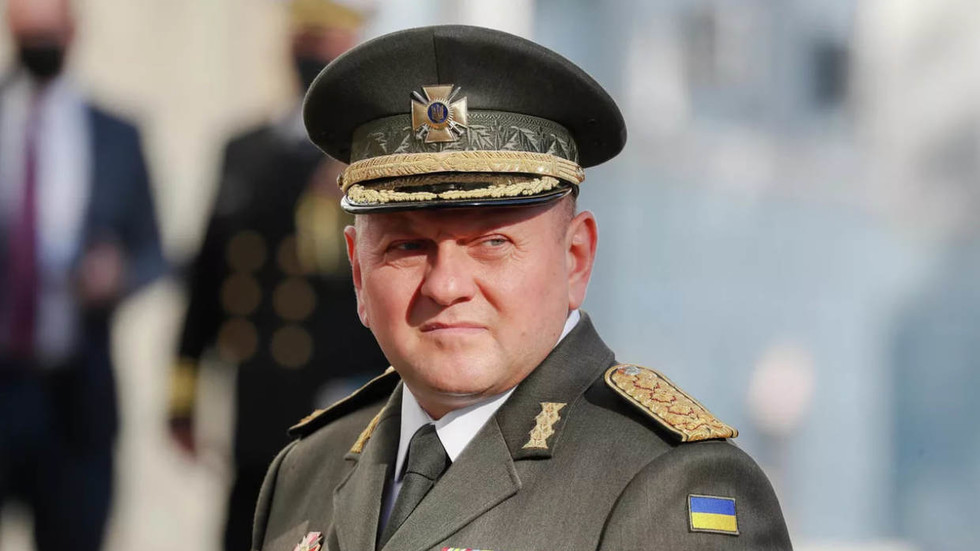
Valery Zaluzhny’s Economist interview and essay are the best feel-good story sympathetic reporters could muster

By Tarik Cyril Amar, a historian from Germany working at Koç University, Istanbul, on Russia, Ukraine, and Eastern Europe, the history of World War II, the cultural Cold War, and the politics of memory
By Tarik Cyril Amar, a historian from Germany working at Koç University, Istanbul, on Russia, Ukraine, and Eastern Europe, the history of World War II, the cultural Cold War, and the politics of memory
@tarikcyrilamartarikcyrilamar.substack.comtarikcyrilamar.com

FILE PHOTO: The commander-in-chief of the Ukrainian Armed Forces Valery Zaluzhny. © AP Photo / Gleb Garanich
General Valery Zaluzhny, Ukraine’s commander-in-chief, has given an important interview to The Economist, a major platform for Western bellicism. The magazine is also hosting his guest essay on ‘Modern Positional Warfare and How to Win in It’.
This is not the first piece time the British outlet has bigged up Zaluzhny. (The general’s well-publicized admiration for Stepan Bandera, the World War II leader of Ukrainian fascists who committed horrendous mass atrocities, has, of course, never troubled a journal that claims to stand for ‘liberalism’.) Indeed, Zaluzhny has consistently received the movie-star treatment: softball questions and shameless PR write-ups masquerading as journalism. And yet, propagandistic as it is, The Economist’s fluff piece still merits attention, if read against the grain.
The first point to note is that it is part of a Western mainstream media trend. After the predictable failure of Ukraine’s summer counteroffensive has finally been acknowledged, a note – if not the substance – of realism is now discernible. Zaluzhny gets to “admit” (The Economist’s word) that the war is “at a stalemate.” While this is still too optimistic when Ukraine and its Western backers are, in reality, losing, it is a departure from the past.
In December 2022, The Economist, even while cautioning that much hard work still lay ahead, claimed there had been a “triumphant” Ukrainian advance in the fall of 2022, again merely reproducing the mainstream narrative of the moment. Serious independent analysts, such as Brian Berletic, were already explaining why this was a gross mischaracterization: Ukrainian forces had re-taken territory in northeastern Ukraine, but at a damaging cost in personnel and materiel. Russia had retreated, but not suffered a strategic setback. It may have looked impressive on a map, and it rattled some Russian commentators, but, in reality, it was a PR stunt Ukraine could not afford. It was precisely not the “counterstrike that turned the tide of the war,” as Time put it back then, in another piece fawning over Zaluzhny. Now, a year later, there are not even such empty territorial gains to show for the lost lives of the counteroffensive.
Even earlier, in March 2022, a “bonanza” of Western weapons was hyped. With this “flood of arms” going beyond tanks and armored fighting vehicles, The Economist fantasized about a whole-sale transformation of Ukraine’s military. That, too, flew in the face of professional expertise: armies, even units inside armies, cannot be transformed at that speed. It is a snake-oil-level silly or dishonest belief. Thanks to it, though, many Ukrainians are dead, wounded, or, if lucky, POWs. Others have long openly admitted that they had to revert to tactics not taught by NATO to stand a chance at survival. Ukraine’s Western ‘supporters’ (would ‘users’ not be the better, more honest word?), meanwhile, accused their proxies of being “casualty-averse.”
Read more
Which brings us back to Zaluzhny’s latest – and very late – insights. The general has recently noticed that “NATO’s textbooks and the math which we did” before launching his counteroffensive were detached from reality. According to them, he has now learned, “four months should have been enough time for us to have reached Crimea, to have fought in Crimea, to return from Crimea and to have gone back in and out again.” He’s “sardonic” about it all, The Economist lets us know. If I were a Ukrainian soldier, I would not appreciate that bit of comic relief. My question to my commander-in-chief would be what took him so bloody long and what’s so funny about it. I would also mutiny or desert.
If it had not wasted so many lives, Zaluzhny’s frank naivete would be touching. It only took him seeing his troops being bogged down in those minefields everyone knew about in advance, while Western miracle weapons turned out to be as susceptible to enemy fire as was easily predictable, to have a remarkable epiphany: This sort of thing is not unprecedented! That’s when he told “his staff to dig out a book he once saw as a student.” Published in 1941 by Soviet general Pavel Smirnov thinking through the experiences of World War I, ‘Breaching Fortified Defense Lines’ turned out relevant, unlike those NATO ‘textbooks’ Zaluzhny was following.
But there is no happy ending here. Zaluzhny has only replaced one set of illusions for another one: Now he believes that Ukraine’s – and very much his own – failure in the counteroffensive is due to a stalemate akin to what made World War I last so long. With contemporary defenders too powerful, thanks to satellites, drones, and other technologies, attackers end up wasting their men and weapons in fruitless or exorbitantly costly attempts to storm almost un-stormable positions. He draws two conclusions: First, Russia has essentially the same problem; and second, the only way to break the stalemate is to introduce more new technology to re-empower the attackers over the defenders. In effect, the man who was surprised that Western arms that already exist are no miracle weapons, now puts his faith in yet more miracle weapons – those still to be developed.
Both of Zaluzhny’s conclusions are bad cases of wishful thinking. Indeed, they are so obviously wrong that one cannot help but recall that this is the man openly admitting he believed NATO ‘textbooks’ and ‘math’ until he saw his soldiers dying in droves.
Here’s why he’s got it wrong again. While it is true that Russia also suffers substantial losses when it launches relatively large, concentrated offensive operations, that does not change the fact that this is a war of attrition, as both Zaluzhny and The Economist have admitted. And it is ongoing: Attrition is constantly working for the (much) stronger country, here Russia, against the (much) weaker country, here Ukraine. Even Zaluzhny admits that any technological breakthrough magically re-empowering Ukraine’s attackers is, at best, far off and, therefore, the war is bound to be long. Yet since there is a limit to the attrition an army can absorb before having to give up or fall apart, Ukraine does not, actually, have the time to wait for Zaluzhny’s new dream of the miracle weapons of the future to come true (if it ever will).

Read more
Of course, Zaluzhny uses his latest appearance in The Economist to ask for more Western arms once again, so as to bridge the gap between the calamitous present and his imagined future. But, in reality, Kiev’s vital, indispensable support from the West is drying up, while Washington is leaking that it’s putting pressure on Zelensky to, in essence, give up. Nothing here adds up. Zaluzhny’s thinking is a mess that will, again, turn bloody.
Secondly, it is astonishing that Zaluzhny still cannot really face the simple fact that Russia as well is constantly learning, adapting, and producing. There is no credible scenario in which, for some reason, Moscow will sit still technologically, while Ukraine overtakes it. Indeed, Zaluzhny’s own observation that Russia also has a problem with making large-scale attacks break through and yield strategic results, should immediately have told him that surely Russia, too, is working on solving this problem. And unlike Ukraine, Russia has the economy to provide it with what it needs to implement its plans. It also has allies because, whether Ukraine’s commander-in-chief has noticed or not, the West’s attempt to isolate Moscow and bring it down through economic warfare have fared no better than Ukraine’s counteroffensive.
Thirdly, Zaluzhny misses two other ways that the Russian military has at its disposal to make progress, one much used now and the other a possibility that he should cause dread. At this point, Russian forces keep most of the line of contact busy with comparatively small-scale operations. Those do not yield any sudden breakthroughs, but they steadily erode Ukrainian positions and improve those of the Russians. In the future, some of the ground thus gained may also serve as launch pads for a big-arrow-style large-scale attack, big enough to overload Ukraine’s weakened, exhausted defenses in more than one place. Does Zaluzhny really believe that his unforgivably late insights into the nature of World War I and the ill-conceived analogies he builds on them will help much in that case?
As Western think tankers in awe of Hollywood movie situation room scenes love to say: What are we looking at here? The simple explanation for this display of being out of touch is despair and a certain simplicity of mind. Perhaps both Zaluzhny and his fans at The Economist are so desperate that they have put together the best feel-good story they could, under the circumstances. And the result is self-damagingly shoddy.
The statements, views and opinions expressed in this column are solely those of the author and do not necessarily represent those of RT.




